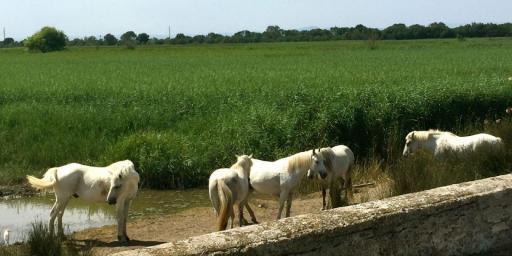7 Reasons You Should Go To The Camargue
It’s hard to say when the Barefoot Blogger will ever get her fill of the Camargue.
The preserved area south of Arles, the Parc naturel régional de Camargue, is between the Mediterranean and the Rhone river delta. One-third of the Camargue is marshland, lagoons and lakes. Continue reading here for the original article and photos.
Camargue Reasons to Visit
The White Horses
Striking white manes and mottled grey-white coats characterize the traditional horses that appear, almost like ghosts, in this swampy terrain. In the equine world, the Camargue horse has been officially recognized by the National Stud Farms since March 17, 1978 — a faithful, even-tempered, sturdy working animal. This horse is a rustic mammal that lives semi-feral within the marshes of the manades (ranches).
Typically, there are several broodmares to a single stallion and foals are born in the wild wearing strangely dark coats, which begin to fade after about three to four years. As yearlings, the foals are branded with the symbol of the manade and separated from their mothers. At the age of three, the males begin training, this is a delicate operation for the gardians (cowboys) who must progressively gain the horses’ confidence.
The Bulls
Black as the night you do not want to meet this creature in a dark alley or tempt fate in the wilds of the Camargue. Bred for show or their meat taureaux (bulls) are never domesticated. The bulls destined for work – games in the arenas or runs in the streets – are identified early. The Camargue bulls (raço di biou) are stocky, never much higher than 4-5 feet with long horns that point to the sky. Horns on Spanish fighting bulls are oriented toward the earth.
The breeding of bulls like the rearing of Camargue horses is extensive, with roughly 120 cowherds and about 20,000 animals (2011 numbers). At a year old, the calves receive the ferrade (brand) of their manade. In the winter months, the animals grow a coarse coat to protect themselves against cooler temperatures this tends to cover the mark. Ear cutting is permitted so that the bulls can be identified from a safe distance.
The meat “Taureau de Camargue” received the designation of origin (AOC) in the late 1990s. The animals feed exclusively on typical plants and grasses of the Camargue, never grain, resulting in a lean, organic protein.
Pink Flamingos
This brackish wetland is, in fact, where two branches of the Rhone River join the sea to form the largest Mediterranean delta after the Nile. It is a bird’s paradise with over 340 species; one of the most recognized is the pink flamingo. In the 1970s, a program was developed to protect the flamingos in the Camargue. Scientists created an artificial island on l’étang du Fangassier to encourage a breeding program, which has been highly successful, with some 10-15,000 couples reproducing a year.
Guided tours are available during the spring and summer months. To read more details on the birds, click here.
The Camargue Cross
Not quite a Latin cross like everything else in the Camargue this emblem is distinctive, with three virtues to fused into one symbol:
- The cross for faith – with a three-pronged fork used by the gardians (cowboys)
- The anchor for hope – recognition of the importance of the sea to the life of the region
- The heart for charity
In Provence terms, the cross is not very old. It was developed by sculptor Hermann Paul in 1924 as a commission for Marquis of Baroncelli.
The Cowboys
Maybe this should be the #1 reason these are ruggedly handsome men!




No Comment